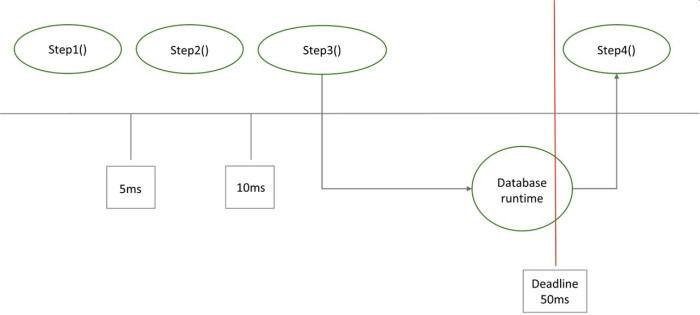Blog > Post
What is and what isn’t a hard real-time database system?
by Steve Graves, McObject (guest author), 29 May 2022
Tags:
Surprisingly, it’s not as simple as it sounds, but perhaps we could start by defining a few terms for our purposes. Hard real-time software is software which fails if a timing deadline is not met. Mission-critical software is software whose failure might cause catastrophic consequences (such as someone dying, damage to property, severe financial losses, etc.). An advanced driver assistance system is mission-critical and hard real-time. An electronic trading system is mission critical, but not hard real-time. An inkjet printer is hard real-time, but not mission critical.
| In other words, in hard real-time systems, there’s a line in the sand with significant consequences. In the context of a real-time database system, the line in the sand is the transaction deadline. Crossing the line means the transaction was late, so the real-time system was not able to respond to an event within the predefined timing constraint. In an advanced driving assistance system, system failure might mean a car accident. |  |
External Consistency
Therefore, a key tenet for a hard real-time database system is deadline management, or external consistency. External consistency means that the content of the database reflects the real world within some time constraint. To achieve this, transactions must complete within pre-set deadlines. In a hard real-time database system, ‘complete’ means meeting the deadline by successfully committing or successfully aborting before the deadline. Transactions can never be late; they must meet deadlines to reflect the state of the real-world or notify interested systems that the transaction missed the deadline (was aborted, but within the deadline). For the sake of reliability, a hard real-time database management system should (but is not required to) enforce internal consistency just like any other ACID database.
Real-time Database System Performance Metric
Hard real-time does not mean real fast. Database and software vendors have been using the term real-time synonymously with instant or live for years. A mission critical hard real-time data management system might want speed, but must be deterministic. In other words, it must work with a RTOS to set and enforce transaction deadlines. Performance is measured by the ratio of transactions that meet their deadline (are successfully committed) to the number of transactions that miss their deadline (are successfully aborted before the deadline). Speed is not a metric used to rate a real-time database system.
Transaction Timeline
As you know, a database transaction is not necessarily a single operation, though it may be. It may be a sequence of operations such as looking up one record, deleting five related records, and updating a field within the original record that must all succeed or fail together. Likewise, a single update or delete command that affects 1 or 100 records must succeed for all or for none.
A transaction begins when the application code invokes it. If the database system is busy with one or more other conflicting transactions, the newly created transaction will be put in a waiting queue, but the clock on its deadline has already started. It’s theoretically possible that a transaction will timeout without ever getting scheduled for execution, but not in a well-designed real-time system. The next figure illustrates the timeline of a real-time transaction.

Once scheduled, the transaction begins executing the workload interval. The database runtime cannot be a black hole from which emergence is indeterminate. In other words, when the system makes a call to the database runtime, the task cannot disappear inside the database runtime for an indeterminate amount of time, possibly exceeding the deadline before the database runtime returns control to the application. The database runtime needs to be aware of the deadline, and be constantly looking at the clock and be able to return control to the application before it’s too late to abort the transaction and allow it to finalize before the deadline. This is the deadline control point.

The ability to deterministically establish the deadline control point depends on being able to know with certainty the time required to abort a transaction. Through implementation of new real-time database transaction schedulers, we can assert that the time required to rollback the changes within a transaction is not more than the time required to apply those same changes. So, if the transaction deadline is T, the deadline control point is T / 2. In reality, aborting a transaction can be substantially faster than the time taken to apply the transaction up to a point in time. So, half of the real deadline is a worst-case scenario that can be adjusted based on empirical data collected during testing and simulations. See Figure 4.

The time to reverse any modifications made to the database by a transaction up to any point in the transaction does not exceed the time required to apply those modifications.
Real-time Transaction Scheduling
The transaction scheduling policy has an impact on the ratio of completed to aborted transactions. First and foremost, a transaction scheduler must enforce the transaction deadline and then attempt to maximize the number of tasks that successfully commit their transactions relative to the number of tasks that have their transactions aborted.
One such policy is High Priority Earliest Deadline First (EDF), and a second is Priority Inheritance (PI). With EDF, transactions are scheduled according to priority, and within the same priority by the earliest deadline. A transaction’s priority is another parameter passed to the transaction scheduler through the transaction start command, along with the deadline.
Priority Inheritance schedules transactions that have the same priority in first-in-first-out order, without regard to their deadlines.
The major difference between the EDF and PI TMs is that in the case of the EDF manager, the database kernel organizes the queue and determines transaction execution order. In the PI case, the execution order is first-in-first-out (FIFO) without respect to deadlines. However, PI raises a lower priority task’s priority to that of a higher priority task when the higher priority task begins a database transaction, allowing the lower priority task to also preempt tasks that are of lower priority than the new high priority task. This, in turn, allows the lower priority transaction to complete quickly and get out of the way of the high priority task. Different application patterns can take advantage of different transaction schedulers.
Conclusion
In summary, a real-time database system may be fast, but must be deterministic and guarantee external consistency. When discussing data management, speed is always a performance metric, but in a hard real-time database, the performance metric that counts most is the number of transactions that successfully commit instead of successfully rolling back on time so that the system can always react instantaneously to mission-critical events. If a database system cannot guarantee external consistency, it is not hard real-time, and could cause the failure of a mission-critical system.
About the Author: |
Steve Graves co-founded McObject in 2001. As the company’s president and CEO, he has both spearheaded McObject’s growth and helped the company attain its goal of providing embedded database technology that makes embedded systems smarter, more reliable and more cost-effective to develop and maintain. Prior to McObject, he was president and chairman of Centura Solutions Corporation, and vice president of worldwide consulting for Centura Software Corporation (NASDAQ: CNTR); he also served as president and chief operating officer of Raima Corporation. Mr. Graves is a member of the advisory board for the University of Washington’s certificate program in Embedded and Real-time Systems Programming. |
Share this page


 RSS Feed
RSS Feed



